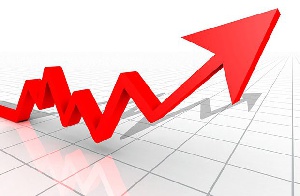For a third consecutive month, consumer inflation has been on an upward trend recording 9.5 percent, year-on-year for the month of April 2019, up from the 9.3 percent recorded in March 2019.
This represents a 0.2 percentage points rise and economists and treasurers alike are expecting that this will translate into upward pressure on short term interest rates. Short term rates have been rising in recent months in response to both rising inflation and pressure on the cedi exchange rate.
The latest rise in consumer price inflation was due to higher non-food inflation, which rose by 0.7 percentage points to 10.4 percent in April from 9.7 percent in March on the back of higher inflation in the various sub-groups such as clothing and footwear, recreation and culture, transport and household equipment and routine maintenance.
However, consumer inflation still remains within the 2019 and medium term fiscal target band of 8±2 percent.
Some industry analysts are of the view that the upward trend in inflation is likely to result in higher treasury yields in this week’s treasury auction.
Furthermore, it would be a key factor to be considered by Bank of Ghana’s Monetary Policy Committee (MPC) which is scheduled to meet next week to review recent developments in the economy to enable it reset – or retain – the benchmark monetary policy rate for the next two months.
The policy rate was maintained at 16.0 percent in the last MPC meeting in March.
The Consumer Price Index (CPI) measures the change over time in the general price level of goods and services that households acquire for the purpose of consumption.
In a press briefing on Wednesday, the Deputy Government Statistician, David Kombat explained that the rise in the inflation rate for the housing, water, electricity, gas and other fuels sub-group was partly due to a base-drift effect, which came about as a result of a 17.5 percent downward adjustment in the price of electricity in April 2018.
Food
In contrast, the food group on the other hand recorded a lower inflation rate of 7.3 percent in April 2019 compared to 8.4 percent recorded in March.
The major food sub-groups which recorded lower inflation rates for April 2019 compared to March 2019 are fruits which inflation rate fell by 2.1 percentage points. Both vegetables and cereals and cereal products sub-groups inflation rate fell by 1.6 percentage points in April 2019.
Regional
At the regional level, the y-o-y inflation rate ranged from 8.0 percent for Upper East region to 11.5 percent for Upper West region. Four regions, Upper West, Brong Ahafo, Western and Ashanti regions, inflation rates above.
Business News of Saturday, 18 May 2019
Source: goldstreetbusiness.com













